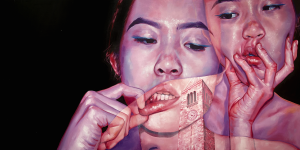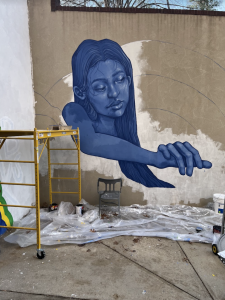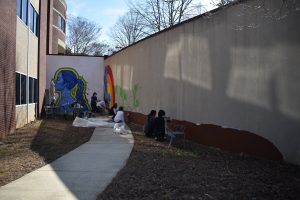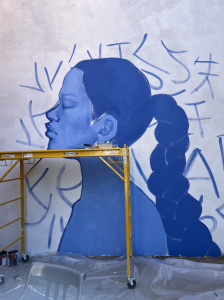During the COVID-19 pandemic in 2021, HPDP decided to create a welcoming outdoor meeting space outside of our offices. To transform the space, we partnered with UNC Arts Everywhere to commission a mural with the themes of health, wellness, and community. This Q&A with the selected artist, Isabel Lu, was originally published on the Arts Everywhere website.

Arts Everywhere recently had the pleasure of working with Isabel Lu, the selected artist for the UNC Center for Health Promotion and Disease Prevention! We spoke to Isabel to get to know the artist behind the mural and talked to them about their artistic journey, inspirations, and dream projects.
Thank you, Isabel, for speaking with us and for sharing your amazing art with the UNC community!
On the Artist
Tell us a little bit about yourself and your artistic journey.
I’m a first-generation Chinese American who grew up in Greensboro, N.C. I’ve been drawing and painting my entire life and I owe a lot of my artistic development to Weaver Academy high school under the mentorship of Steven Cozart. I earned my B.S. in Nutritional Sciences at Cornell University and am currently completing my Masters in Public Health at Gillings. I plan to pursue a career in health equity research focused on Asian American experiences with food and nutrition.
I primarily work with oil paints and portraiture, but also work in digital media as a graphic designer. My work journeys personal growth unpacking internalized racism, aphobia, and body image, and explores how we visualize and interpret the same image in different ways, based on our biases and identities. In both art and academia, Asians are not necessarily underrepresented in the workforce, but our community’s needs, struggles, and knowledge are aggregated, disregarded, and appropriated. Our bodies and minds are used but not seen or understood. Through both traditional and expressionist portrait painting techniques, I intentionally place our bodies as the subjects of my work. As a practice of accountability, I lean into personal struggles of discomfort, such as wearing eyelid tape for 8 years in order to have a larger double fold, avoiding tanning and “yellowing” of skin, and experiencing the manipulation of BIPOC voices and experiences in public health advocacy. My work requires the participation of the audience to recognize the devices in my paintings and ask themselves how they have observed, participated, and/or experienced those events.

Who or what are your inspirations?
Recently, my work is heavily inspired by how Asian American, gender, and sexual identity are expressed and interpreted by ourselves and others. I usually get inspiration for a painting through conversations with people who share experiences with me and through other BIPOC artists.

Tell us about a favorite project of yours.
This mural! This opportunity to conceptualize and execute a piece of public art about health equity and research seemed like a once-in-a-lifetime chance. This was my first mural, and the installation process was terrifying, physically demanding, and exciting all at the same time. I smile when I think about my art being enjoyed by anyone in a public space.
What’s your dream project?
I would love to collaborate on another mural with other AAPI artists in a public space that is accessible and welcoming to AAPI and queer communities.
One word to describe your art?
‘Accountability’ for both myself and the audience.
On the Mural

What drew you to apply for this mural?
I currently work at HPDP as a graduate research assistant on the FFORC team. When I read the application for this mural project and saw that they were looking for a design aligned with the mission of health equity and community-engaged research, I thought it was a perfect opportunity to merge my two passions: art and health equity research.
You said that your design process began with a quote from Farmer Howard Allen. How did that inspire this piece? How does HPDP’s belief of health equality, inclusiveness, and diversity shine through in your mural?
I did an interview with Howard for my job last year about his work related to regenerative agriculture and food justice. He said, “We can sow seeds every day. Some will bloom tomorrow, some in 100 years.” Our actions today lay the groundwork for the landscape of the next day, next year, and next century. And when I think about who has had the most influence in our long history for equitable health and food, it’s women of color. I think about Indigenous and African women who braided seeds in their hair as an act of cultural and self-preservation, knowing that if they could grow their own food, they could survive. I think about my mother teaching me Chinese medicinal foods, such as red dates, white fungus, and ginseng, to warm my body in the winter months. I think about the women of color in academia who continue to challenge conventional research methods, shift conversations, and center underrepresented communities in institutions historically barred from them. As a public health researcher and artist, these are the women that inspire me to push research and art towards justice by acknowledging historic oppressions and centering women’s knowledge and experiences. HPDP has been a space where my voice as an artist, a researcher, and an individual has been supported and accepted.

Is the mural titled? What’s the meaning behind it?
I always find it difficult to distill a piece down to one title. While I have my own interpretation and ideas of what this mural means, I want viewers to experience it on their own terms and through conversations with each other. So, I don’t have a title for it!
Why was it important to you to include staff in the process of installing the piece? How was that experience?
Ownership, access to, and experiencing a space is important. Ultimately, this mural is located at HPDP’s home, and will experienced by the staff daily. Additionally, just like participatory research, I always prioritize the involvement and partnership of all parties to shape the direction and goals of a project. So, it was imperative that the HPDP staff was involved in the finalization of the design and installation of the piece.
We had a beautiful afternoon in February where a lot of staff came out to paint. It was a great experience getting people involved in the physical creation of the mural.

What’s your favorite aspect of the mural?
With both the mural and my other works, the painting process itself is extremely therapeutic. Spending hours and hours on a piece allows me to reflect on the intent of the painting and how my original design presents those thoughts. I bring elements in, push things back, and lean into directions that give more meaning to the piece. In this mural, I added elements of Chinese line art to both the figures and the backgrounds that put my identity more into it. The linework on the woman throwing seeds into the Earth represent the flow of wisdom and knowledge from her body to the next generations. The clouds on the woman in profile represent a dreamy and child-like quality of women; a reminder that women are not just caretakers, workers, and objects of sexuality, but are individuals who, themselves, dream, play, and inspire ourselves.

Previously, the space was intimidating and uninviting for HPDP staff and community members. What do you hope will come of this transformed space?
While this piece does have more of a deeper message about food systems and health equity, ultimately, I hope that my art can be something that celebrates life and brings joy to people. I hope this piece can foster a space where people enjoy themselves, each other, and a reminder that there are individual and generational impacts f the work we do.
Learn more about Isabel Lu on their website or on Instagram.
